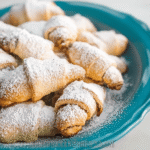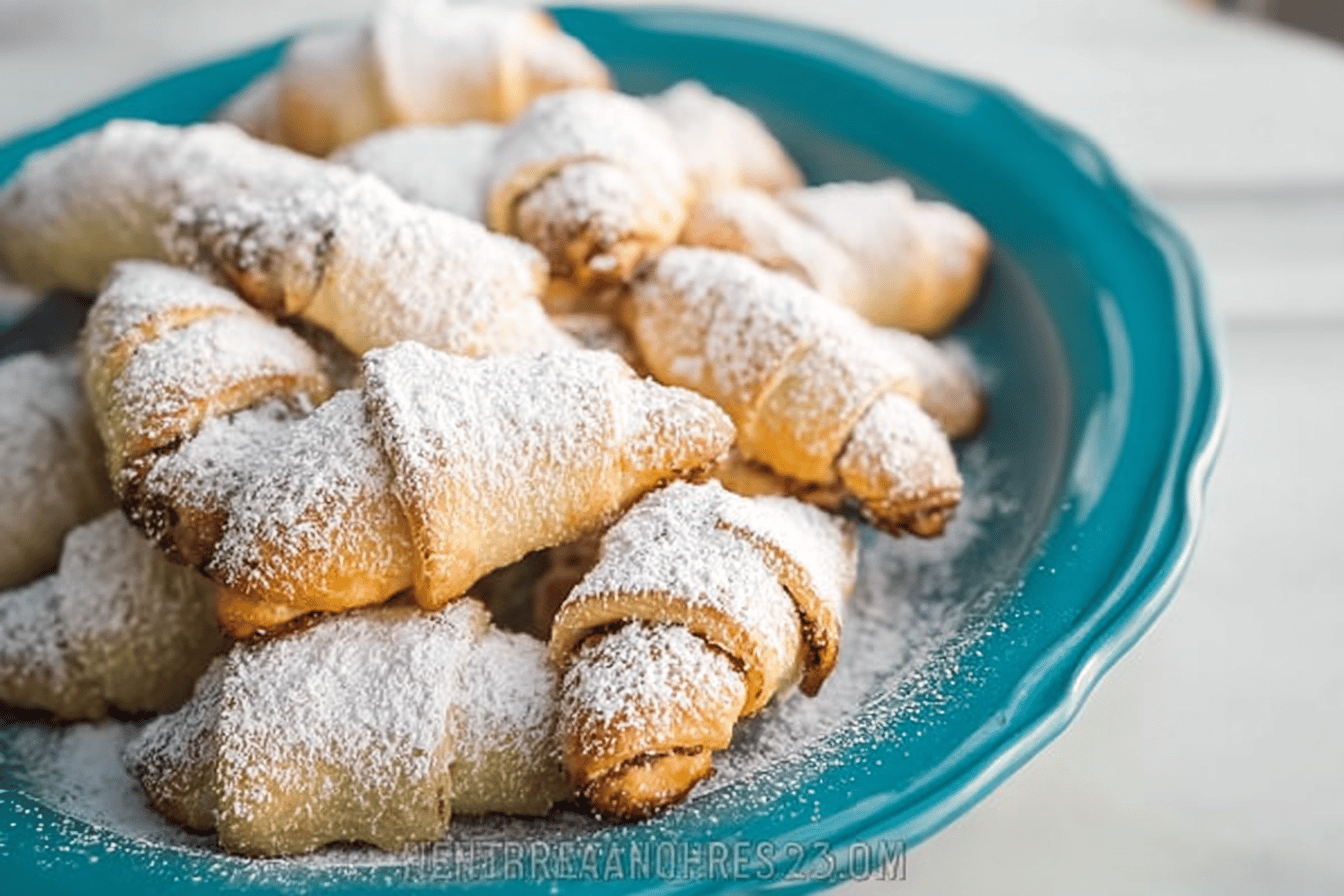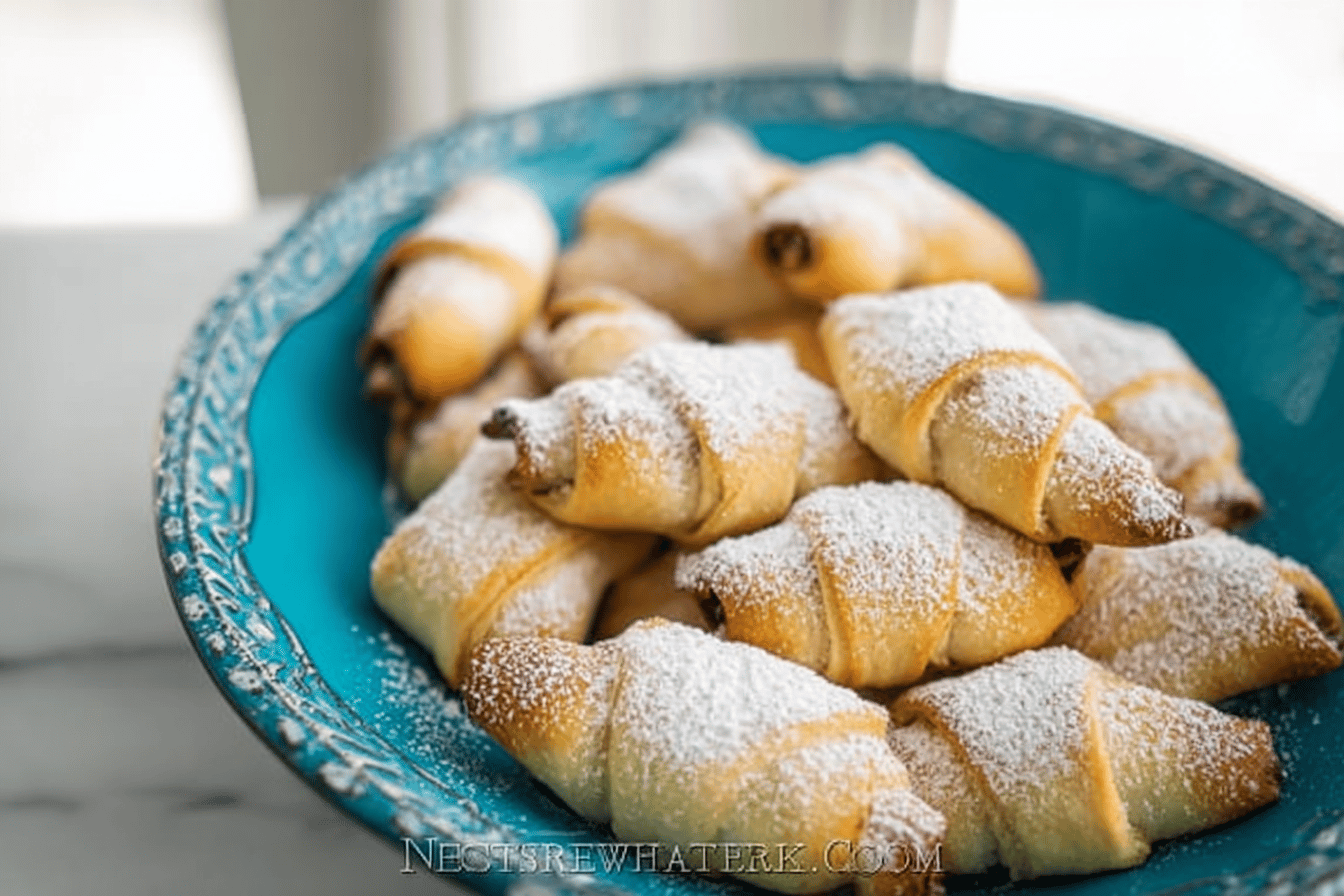Why You’ll Love This Russian Rugelach
If you’re a fan of traditional pastries, this Russian Rugelach recipe is about to become your new go-to treat. It’s simple to whip up, especially on busy days when you want something homemade without spending hours in the kitchen. Plus, the delightful blend of flavors makes it a hit for family gatherings or a quiet afternoon snack.
One reason you’ll adore it is the ease of preparation. This Russian Rugelach recipe is simple and quick to make, requiring minimal ingredients and straightforward steps that save you time in the kitchen. You’ll appreciate how it offers health benefits too, with rich yet wholesome ingredients providing healthy fats, moderate sugar levels, and antioxidants to support your overall wellness.
Don’t forget about its versatility. This pastry adapts easily to various dietary needs, so you can tweak it for vegan, gluten-free, or low-calorie preferences without losing that classic taste. Explore more cheesecake-inspired treats like this one on our blog for endless inspiration.
Jump To
- 1. Why You’ll Love This Russian Rugelach
- 2. Essential Ingredients for Russian Rugelach
- 3. How to Prepare the Perfect Russian Rugelach: Step-by-Step Guide
- 4. Dietary Substitutions to Customize Your Russian Rugelach
- 5. Mastering Russian Rugelach: Advanced Tips and Variations
- 6. How to Store Russian Rugelach: Best Practices
- 7. FAQs: Frequently Asked Questions About Russian Rugelach
- 8. Russian Rugelach
Essential Ingredients for Russian Rugelach
Gathering the right ingredients is the first step to creating perfect Russian Rugelach. This recipe focuses on simple, everyday items that come together to form a delicious pastry. Let’s break down what you need to get started, making sure everything is listed clearly for your convenience.
- 2 sticks unsalted butter (113g each), melted but not hot
- 1 cup warm milk (1% or 2% milk)
- 4 cups all-purpose flour
- 3/4 tablespoon active dry yeast
- Sugar (amount as needed for sprinkling)
- Blackcurrant preserves or any preferred preserves such as raspberry or blackberry
These ingredients make about 60 rugelachs, so you’ll have plenty to share. For special dietary options, you can make substitutions like using plant-based milk for vegans or a gluten-free flour blend to accommodate sensitivities.
| Ingredient Category | Base Option | Substitution for Dietary Needs |
|---|---|---|
| Dairy and Fats | Unsalted butter and milk | Use plant-based margarine and almond milk for vegan versions |
| Flours and Leaveners | All-purpose flour and yeast | Opt for gluten-free flour blends if needed |
| Sweeteners and Fillings | Sugar and preserves | Reduce sugar for low-calorie diets or choose sugar-free preserves |
This structured list ensures you have everything measured out precisely, making your baking experience smooth and enjoyable. Check out similar baking recipes for more ideas on using these ingredients creatively.
How to Prepare the Perfect Russian Rugelach: Step-by-Step Guide
Making Russian Rugelach at home is a fun and rewarding process that brings a touch of tradition to your table. Start by preheating your oven to 360°F (182°C) and melting the butter over low heat until it’s warm but not hot. This sets the stage for a dough that’s soft and easy to work with.
Gathering and Mixing the Dough
Once your butter is ready, transfer it to a mixing bowl and use an electric mixer with a whisk attachment on medium speed to combine it with the warm milk. In another bowl, mix the flour and yeast together before gradually adding it to the butter mixture. Switch to the paddle attachment and add the flour about half a cup at a time until the dough is consistent and doesn’t stick to the bowl, which takes 3 to 5 minutes.
The dough should feel soft and not sticky, perfect for rolling. Divide it into five equal portions, cover with plastic wrap, and let it sit at room temperature until you’re ready to shape your pastries.
Rolling and Filling the Pastries
Roll out one portion on a smooth non-stick surface into an 11-inch circle, without using any flour on the surface. Sprinkle sugar evenly over the dough and make 6 cuts from the center to the edge to create 12 triangles. Place a marble-sized amount of preserves at the wide end of each triangle and roll toward the center, pressing the edges after the first roll to keep the filling inside.
Arrange the rolled pastries on a baking sheet with the pointed end down, spacing them about half an inch apart. Let them rise in a warm oven set to 100°F (38°C) for 30 to 45 minutes, or in a warm room until they’ve grown about 50% in size this might take up to 2 hours.
Baking and Finishing Touches
Bake at 360°F (182°C) for 20 minutes or until they’re golden brown. Right after baking, transfer them to a bowl and dust generously with powdered sugar for that sweet finish. This step-by-step guide makes the process straightforward, even if you’re new to baking.
When you pull these golden treats from the oven, you’ll see why they’re a favorite the aroma alone is irresistible!
Dietary Substitutions to Customize Your Russian Rugelach
One of the best parts about Russian Rugelach is how flexible it is for different diets. If you’re looking to make it your own, start with simple swaps that keep the taste intact. For instance, replace the butter with a plant-based alternative if you’re going dairy-free.
- Protein and main component alternatives: Use vegan cream cheese or ricotta in place of dairy items for lighter or dairy-free options.
- Use almond flour or gluten-free flour blends instead of all-purpose flour to suit those with gluten sensitivity.
For vegetable, sauce, and seasoning modifications, try adding finely chopped nuts or dried fruits as fillings. You can also swap traditional preserves for sugar-free versions to make it diabetes-friendly, and tweak spices like cinnamon to match your mood.
Mastering Russian Rugelach: Advanced Tips and Variations
Once you’re comfortable with the basics, level up your Russian Rugelach with some pro tips. Keep your ingredients chilled to get that optimal dough texture, and make sure to roll it out evenly for consistent baking results. This helps every bite turn out just right.
Flavor Experiments and Presentation
Experiment with different fillings like chocolate-hazelnut spread or savory cheese blends to add a twist. For a polished look, dust your finished Rugelach with powdered sugar or drizzle on melted chocolate it’s an easy way to impress guests.
Make-ahead options are a game-changer for busy days. Prepare and freeze the unbaked pastries, then bake them straight from frozen when you need a quick treat. Discover more about Russian baked goods for additional inspiration on variations.
How to Store Russian Rugelach: Best Practices
Storing your Russian Rugelach properly keeps them fresh and tasty for longer. Put baked ones in an airtight container and keep them in the fridge for up to 5 days. If you want to stock up, freezing is a great option wrap pieces tightly and they can last up to 3 months.
- Refrigeration: Store in an airtight container for up to 5 days.
- Freezing: Wrap individually and freeze for up to 3 months.
- Reheating: Warm in the oven at 300°F for 5-7 minutes.
- Meal prep: Batch bake and freeze for easy snacks anytime.
This approach makes it simple to enjoy your Rugelach throughout the week without any fuss. Explore the benefits of yeast to understand how it contributes to the pastry’s longevity.

FAQs: Frequently Asked Questions About Russian Rugelach
What is Russian Rugelach and how is it different from other pastries?
Russian Rugelach is a traditional Eastern European pastry made from a cream cheese-based dough rolled around various fillings like fruit preserves, nuts, cinnamon, or chocolate. Unlike mainstream croissants or Danish pastries, Rugelach has a distinctive crescent shape and a tender, slightly flaky texture due to the cream cheese in the dough. This combination creates a rich, moist pastry that isn’t overly sweet, making it perfect for breakfast or dessert.
How do you make the dough for authentic Russian Rugelach?
Authentic Russian Rugelach dough is typically made by combining cream cheese, butter, flour, and a pinch of salt. The cream cheese and butter are chilled, then cut into the flour to form a soft but firm dough. After chilling the dough for at least an hour, it’s rolled out thinly before adding fillings. This cream cheese dough is key to achieving Rugelach’s signature tender and flaky crust.
What are common fillings used in Russian Rugelach recipes?
Popular fillings for Russian Rugelach include fruit preserves such as apricot or raspberry, finely chopped nuts like walnuts or pecans, cinnamon sugar, and sometimes raisins or chocolate chips. The fillings can be mixed or layered depending on taste. Using high-quality preserves or freshly ground nuts helps enhance the pastry’s flavor and texture.
Can Russian Rugelach be made ahead and frozen?
Yes, Russian Rugelach can be made ahead and frozen either before or after baking. To freeze unbaked Rugelach, shape them on a baking sheet, freeze until solid, then transfer to a freezer bag. Bake directly from frozen, adding a few extra minutes to the baking time. For baked Rugelach, allow them to cool fully, then freeze in an airtight container. Thaw at room temperature and warm briefly before serving for best taste.
How should Russian Rugelach be stored to maintain freshness?
To keep Russian Rugelach fresh, store them in an airtight container at room temperature for up to 3 days. If you want to extend freshness, refrigerate them for up to a week, but allow them to come to room temperature before eating. Avoid storing Rugelach in a humid environment as it may affect the dough’s texture. For longer storage, freezing as described above is recommended.

Russian Rugelach
- Total Time: 2 hours 40 minutes
- Yield: About 60 rugelach pastries
- Diet: Vegetarian
Description
🥐 Russian Rugelach and Rogaliki offer traditional flaky pastries filled with flavorful preserves, perfect for those who cherish classic desserts.
🍇 This easy-to-follow recipe creates soft, tender dough with a sweet filling, making it ideal for family gatherings or festive occasions.
Ingredients
– 2 sticks unsalted butter (113g each) melted but not hot
– 1 cup warm milk (1% or 2% milk)
– 4 cups all-purpose flour
– 3/4 tablespoon active dry yeast
– Sugar as needed for sprinkling
– Blackcurrant preserves or any preferred preserves such as raspberry or blackberry
Instructions
1-Making Russian Rugelach at home: Start by preheating your oven to 360°F (182°C) and melting the butter over low heat until it’s warm but not hot. This sets the stage for a dough that’s soft and easy to work with.
2-Gathering and Mixing the Dough: Once your butter is ready, transfer it to a mixing bowl and use an electric mixer with a whisk attachment on medium speed to combine it with the warm milk. In another bowl, mix the flour and yeast together before gradually adding it to the butter mixture. Switch to the paddle attachment and add the flour about half a cup at a time until the dough is consistent and doesn’t stick to the bowl, which takes 3 to 5 minutes.
The dough should feel soft and not sticky, perfect for rolling. Divide it into five equal portions, cover with plastic wrap, and let it sit at room temperature until you’re ready to shape your pastries.
3-Rolling and Filling the Pastries: Roll out one portion on a smooth non-stick surface into an 11-inch circle, without using any flour on the surface. Sprinkle sugar evenly over the dough and make 6 cuts from the center to the edge to create 12 triangles. Place a marble-sized amount of preserves at the wide end of each triangle and roll toward the center, pressing the edges after the first roll to keep the filling inside.
Arrange the rolled pastries on a baking sheet with the pointed end down, spacing them about half an inch apart. Let them rise in a warm oven set to 100°F (38°C) for 30 to 45 minutes, or in a warm room until they’ve grown about 50% in size this might take up to 2 hours.
4-Baking and Finishing Touches: Bake at 360°F (182°C) for 20 minutes or until they’re golden brown. Right after baking, transfer them to a bowl and dust generously with powdered sugar for that sweet finish. This step-by-step guide makes the process straightforward, even if you’re new to baking.
Notes
🕰️ Allow sufficient rising time for light, fluffy pastries.
❄️ Use warm but not hot butter to avoid killing yeast.
🍽️ Press edges after rolling to seal preserves and prevent leakage during baking.
- Prep Time: 20 minutes
- Rising time: 45 minutes to 2 hours
- Cook Time: 20 minutes
- Category: Dessert
- Method: Baking and rolling
- Cuisine: Russian
Nutrition
- Serving Size: 1 pastry
- Calories: 120 kcal
- Sugar: 5 g
- Sodium: 30 mg
- Fat: 6 g
- Saturated Fat: 4 g
- Trans Fat: 0 g
- Carbohydrates: 15 g
- Fiber: 1 g
- Protein: 2 g
- Cholesterol: 20 mg
Keywords: Russian rugelach, Rogaliki pastries, Traditional Russian desserts, Preserves filled rugelach


